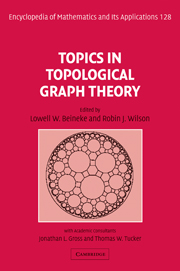Book contents
- Frontmatter
- Contents
- Foreword
- Preface
- Introduction
- 1 Embedding graphs on surfaces
- 2 Maximum genus
- 3 Distribution of embeddings
- 4 Algorithms and obstructions for embeddings
- 5 Graph minors: generalizing Kuratowski's theorem
- 6 Colouring graphs on surfaces
- 7 Crossing numbers
- 8 Representing graphs and maps
- 9 Enumerating coverings
- 10 Symmetric maps
- 11 The genus of a group
- 12 Embeddings and geometries
- 13 Embeddings and designs
- 14 Infinite graphs and planar maps
- 15 Open problems
- Notes on contributors
- Index
1 - Embedding graphs on surfaces
Published online by Cambridge University Press: 05 June 2012
- Frontmatter
- Contents
- Foreword
- Preface
- Introduction
- 1 Embedding graphs on surfaces
- 2 Maximum genus
- 3 Distribution of embeddings
- 4 Algorithms and obstructions for embeddings
- 5 Graph minors: generalizing Kuratowski's theorem
- 6 Colouring graphs on surfaces
- 7 Crossing numbers
- 8 Representing graphs and maps
- 9 Enumerating coverings
- 10 Symmetric maps
- 11 The genus of a group
- 12 Embeddings and geometries
- 13 Embeddings and designs
- 14 Infinite graphs and planar maps
- 15 Open problems
- Notes on contributors
- Index
Summary
In this first chapter, we review the basic ideas of topological graph theory. We describe the principal early theme of constructing embeddings, and we then survey the launching of the dominant programmatic themes of the present era, which are presented in greater detail individually in subsequent chapters.
Introduction
By the late 19th century, the work of Heawood [16] and Heffter [17] had expanded the study of graph drawings beyond the confines of the plane to surfaces of higher order. Over the next hundred years or so, the solution of several long-standing problems attracted many researchers and the present-day programmatic themes were set into place. Of course, some of the methods used in the solutions led to new problems. Topological graph theory is now one of the largest branches of graph theory.
This chapter gives a brief overview of some of the principal concepts, terminology and notation of topological graph theory. As general resources, we recommend [13], Chapter 7 of [14], [22] and [44].
Graphs and surfaces
We start by recalling some definitions from the Introduction. A graph G is formally defined to be a combinatorial incidence structure with a vertex-set V and an edgeset E, where each edge e is incident with at most two vertices; we may write VG and EG, respectively, when there is more than one graph under consideration. A graph may have multiple adjacencies and loops and is usually taken to be finite unless the immediate context implies otherwise.
- Type
- Chapter
- Information
- Topics in Topological Graph Theory , pp. 18 - 33Publisher: Cambridge University PressPrint publication year: 2009



